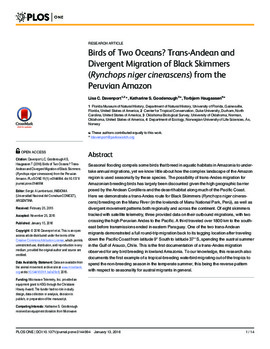| dc.contributor.author | Lisa C. Davenport | |
| dc.contributor.author | Katharine S. Goodenough | |
| dc.contributor.author | Torbjørn Haugaasen | |
| dc.date.accessioned | 2017-03-04T01:59:48Z | |
| dc.date.available | 2017-03-04T01:59:48Z | |
| dc.date.issued | 2016-01-13 | |
| dc.identifier.citation | Davenport LC, Goodenough KS, Haugaasen T (2016) Birds of Two Oceans? Trans-Andean and Divergent Migration of Black Skimmers (Rynchops niger cinerascens) from the Peruvian Amazon. PLoS ONE 11(1): e0144994. doi:10.1371/journal.pone.0144994 | en_US |
| dc.identifier.uri | https://hdl.handle.net/11244/49229 | |
| dc.description | We are grateful for assistance from John Terborgh, Antonio Guerra Rosas, Marcos Maguiña, Inés Nole, John Takekawa, Lisa Ferguson, Juan Kapeshi, Nikanor Kapeshi, Cathy Bykowsky, Chi (Tim) Lam, Scott Robinson, Fabrice Schmitt, and Cesar Flores. Alex Jahn, Ugo Mellone, Sergio Lambertucci and one anonymous reviewer provided comments that helped improve the manuscript. | en_US |
| dc.description | | en_US |
| dc.description.abstract | Seasonal flooding compels some birds that breed in aquatic habitats in Amazonia to undertake annual migrations, yet we know little about how the complex landscape of the Amazon region is used seasonally by these species. The possibility of trans-Andes migration for Amazonian breeding birds has largely been discounted given the high geographic barrier posed by the Andean Cordillera and the desert habitat along much of the Pacific Coast. Here we demonstrate a trans-Andes route for Black Skimmers (Rynchops niger cinerascens) breeding on the Manu River (in the lowlands of Manu National Park, Perú), as well as divergent movement patterns both regionally and across the continent. Of eight skimmers tracked with satellite telemetry, three provided data on their outbound migrations, with two crossing the high Peruvian Andes to the Pacific. A third traveled over 1800 km to the southeast before transmissions ended in eastern Paraguay. One of the two trans-Andean migrants demonstrated a full round-trip migration back to its tagging location after traveling down the Pacific Coast from latitude 9° South to latitude 37° S, spending the austral summer in the Gulf of Arauco, Chile. This is the first documentation of a trans-Andes migration observed for any bird breeding in lowland Amazonia. To our knowledge, this research also documents the first example of a tropical-breeding waterbird migrating out of the tropics to spend the non-breeding season in the temperate summer, this being the reverse pattern with respect to seasonality for austral migrants in general. | en_US |
| dc.language.iso | en_US | en_US |
| dc.publisher | PLos One | |
| dc.relation.ispartofseries | PLoS ONE 11(1): e0144994 | |
| dc.relation.uri | http://www.plosone.org/article/info%3Adoi%2F10.1371%2Fjournal.pone.0144994 | |
| dc.rights | Attribution 3.0 United States | |
| dc.rights.uri | https://creativecommons.org/licenses/by/3.0/us/ | |
| dc.subject | Animal migration,Birds,Animal sexual behavior,Beaches,Latitude,Rivers,Fresh water,South America | en_US |
| dc.title | Birds of Two Oceans? Trans-Andean and Divergent Migration of Black Skimmers (Rynchops niger cinerascens) from the Peruvian Amazon | en_US |
| dc.type | Research Article | en_US |
| dc.description.peerreview | Yes | en_US |
| dc.description.peerreviewnotes | http://www.plosone.org/static/editorial#peer | en_US |
| dc.identifier.doi | 10.1371/journal.pone.0144994 | en_US |
| dc.rights.requestable | false | en_US |

